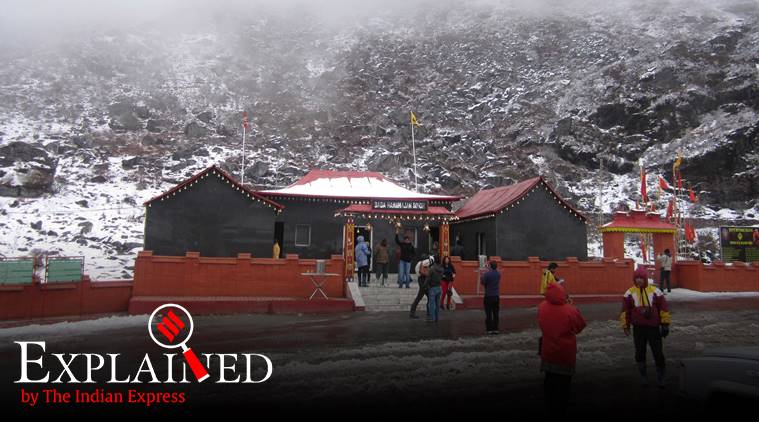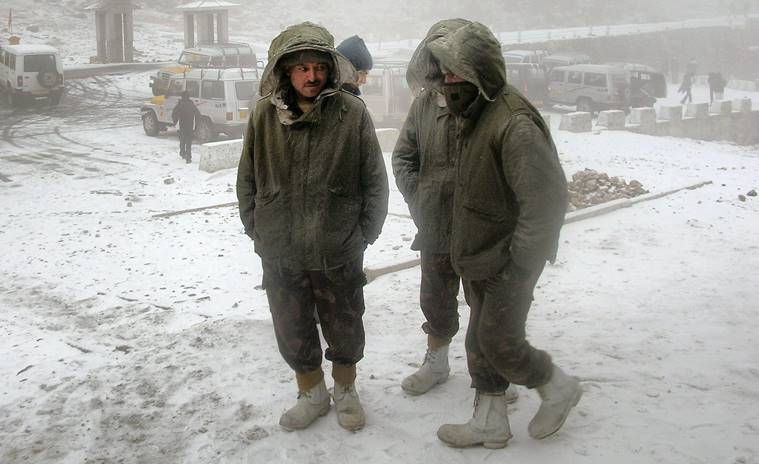- India
- International
India-China border dispute: What happened in Nathu La in 1967?
The last military skirmish between India and China took place at Nathu La in September 1967. Before it escalated to artillery guns and threats of fighter jets, there was a scuffle between the soldiers of the two armies.
 Baba Harbhajan Singh temple at Nathu La pass. (Express Archive)
Baba Harbhajan Singh temple at Nathu La pass. (Express Archive)
As reports of deaths of Indian soldiers in a violent faceoff on Ladakh border emerged, many took solace from the fact that no rounds were fired during the physical clash with the Chinese soldiers.
While this certainly makes these deaths more brutal than being shot and killed, it also gives hope that an escalation to kinetic means – rifles, howitzers, rockets, missiles and fighter jets – can be avoided between the two nuclear neighbours.
The history of the conflict between the two sides, however, splashes some cold water on such hopes.
The last military skirmish between India and China took place at Nathu La in September 1967. Before the skirmish escalated to artillery guns and threats of fighter jets, there was a scuffle between the soldiers of the two armies.
The clash eventually left 88 Indian soldiers dead. More than 300 Chinese soldiers were killed.

 Indian Army personnel at the Indo-China border in Nathu La, Sikkim. (PTI Photo/File)
Indian Army personnel at the Indo-China border in Nathu La, Sikkim. (PTI Photo/File)
In the weeks and months ahead of the clash, the Indian side had decided to fence the border with three layers of barbed wire. Work started on August 20, 1967.
On August 23, about 75 Chinese in battle dress, carrying rifles fitted with bayonets, advanced slowly towards Nathu La in an extended line, and stopped at the border. The Political Commissar — identifiable by a red patch on his cap, and the only one who could speak some English — read out slogans from a red book, which the rest of the party shouted after him.
The Indian troops were “standing to”, watching and waiting. After about an hour, the Chinese withdrew. But they returned later, and continued their protests.

On September 5, as the barbed wire fence was being upgraded to a concertina coil, the Political Commissar had an argument with the Commanding Officer of the local infantry battalion, Lt Colonel Rai Singh. Thereafter, work stopped.
Work was, however, resumed on September 7. This provoked about 100 Chinese soldiers to rush up, and a scuffle ensued. Beaten down by the Jats, the Chinese resorted to stone-pelting, and the Indians responded in kind.
On September 10, the Chinese sent across a warning through the Indian embassy: “The Chinese Government sternly warns the Indian Government: the Chinese Border Defence Troops are closely watching the development of the situation along the China-Sikkim boundary. Should the Indian troops continue to make provocative intrusions, the Indian Government must be held responsible for all the grave consequences.”
Read | 18 Modi-Xi meetings, several pacts: killings breach consensus, dent diplomacy
The corps commander had ordered the fence to be completed on September 11. That day, as work started, the Chinese came to protest, led by the Political Commissar. Lt Col Rai Singh went out to talk to them.
Suddenly, the Chinese opened fire, and Singh fell to the ground, injured.
Seeing their CO hit, the infantry battalion attacked the Chinese post. But they suffered heavy casualties, including two officers, who were both given gallantry awards. Soldiers in the open were mowed down by Chinese machine gun fire.
The Indians responded with artillery fire, and pummelled every Chinese post in the vicinity. Many more Chinese perished in these heavy fire assaults than the number of Indians who were killed in the initial engagement.
Taken aback by the strong Indian response, the Chinese threatened to bring in warplanes. When the Indians refused to back off, the Chinese news agency Xinhua denied these plans.
 Indian Army personnel at Nathula, Indo-China border, in February 2008. (PTI Photo/File)
Indian Army personnel at Nathula, Indo-China border, in February 2008. (PTI Photo/File)
Having sent its message militarily, India, on September 12, delivered a note to the Chinese, offering an unconditional ceasefire across the Sikkim-Tibet border beginning 5.30 am on September 13. This was rejected, but the situation remained largely peaceful until the 14th.
Don’t miss from Explained | What the clash in Ladakh underlines, and what India must do in face of the Chinese challenge
On September 15, the Chinese handed over the bodies of Indian soldiers with arms and ammunition, saying they were acting in the interest of “preserving Sino-Indian friendship”.
On October 1, another skirmish erupted at Cho La, but the Indians again repulsed the Chinese.
More Explained
EXPRESS OPINION
Apr 23: Latest News
- 01
- 02
- 03
- 04
- 05








































